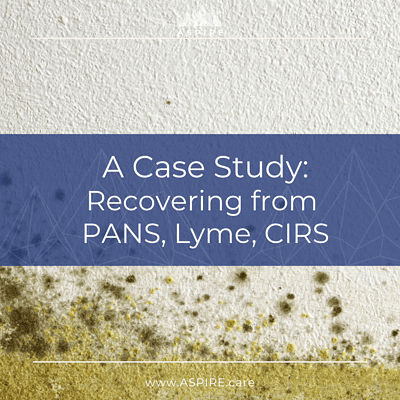PANS Symptom Severity
The severity of PANS symptoms varies from patient to patient and can vary from flare to flare.
Treatment plans reflect the severity of the current PANS flare and case history. Not all patients return to baseline between flares, which can affect treatment plans. PANS is a clinical condition identified by an abrupt onset of a specific cluster of symptoms as a result of a variety of etiologies and disease mechanisms. Therefore, tracking symptoms and their onset, severity, and duration is critical to making a clinical diagnosis. Both clinicians and parents can use PANS symptomology rating scale tools to monitor symptom severity. More information on PANS Rating Scales and Symptom Tracking.
Mild Symptomology
Mildly severe PANS PANDAS symptoms interfere with daily life but are manageable and do not completely debilitate the patient.
Mild PANS PANDAS symptoms may present in some situations but not in all. For example, a patient may be able to attend school with some reservations but once back home is definitely anxious about being separated from a parent, needing significantly more attention than before the flare. Obsessive-compulsive symptoms occupy 1 to 2 hours of the patient’s day without escalating to obsessional fears.
- Symptoms interfere with daily life but not in all settings.
- The patient is able to attend school but with separation anxiety.
- OCD occupies 1-2 hours a day without escalating to obsessional fears.
- Other symptoms vary from patient to patient and from flare to flare but are not incapacitating.
- Symptoms require some school accommodations.
Moderate Symptomology
Moderately severe PANS symptoms interfere with daily life; some symptoms are less manageable, significantly negatively hindering a majority of activities.
Obsessive-compulsive symptoms are present 50% to 70% of a patient’s waking hours but do not interfere with all activities. For example, a patient may not be able to attend school but may be able to go to a friend’s house if a parent is with them. Other symptoms are also moderately severe; they impact the patient most of the day but are not completely incapacitating at all times.
- OCD occupies 50%-70% of the waking day. Impacts daily activities severely but not fully disabling.
- Other symptoms are also moderate; impact daily life but not incapacitating.
- School attendance may be affected, but the patient may be able to engage in other activities.
- Symptoms require increased school accommodations and supports.
Severe Symptomology
PANS symptoms are severe when neuropsychiatric symptoms cause life-threatening situations.
Serious weight loss (>10%-15% of body mass) can be a result of obsessional eating restrictions associated with fear of vomiting or choking, fear of contamination, and other reasons. Severe impulsivity or severe behavioral regression can manifest in life-threatening ways such as jumping from heights or moving cars or threatening harm to self or others with knives or other dangerous objects. Aggressive treatment is typically necessary. Obsessive-compulsive thoughts are dominant, occupying 80%-100% of waking hours, obstructing most daily functioning like attending school, showering, performing simple tasks. Separation anxiety is equally extreme; patients often can barely leave the house, will not separate from parents at all and sleep in the parent’s bed. Other symptoms may be equally impacted, including increased aggression, emotional lability, and irritability.
- Neuropsychiatric symptoms can result in life-threatening situations.
- Hazardous Impulsivity and/or Regression
- Weight Loss (>10%-15% of body mass) due to obsessional food restrictions & fear
- OCD, anxiety, and fears occupy 80%-100% of waking day.
- Unable to attend school due to OCD and Separation Anxiety.
- Irritability, Liability to self and others, Aggression, and other symptoms can be equally present.

Learn more about PANS & PANDAS Symptoms
Learn more about PANS PANDAS Disease Course
We aspire to share.
Learn about other families whose lives have been affected by PANS/PANDAS — and be inspired to share your own.

Case Study – Recovering from PANS, Lyme, CIRS
A Talk with Nathan Who is Recovering from PANS/PANDAS, Lyme & CIRS Gabriella: I had a chat with Dr. Nancy O’Hara, Nathan, and his mom a few years ago and […]